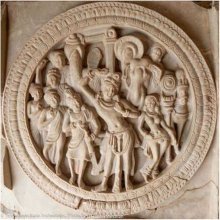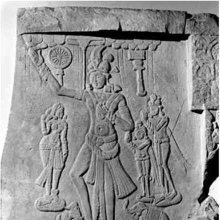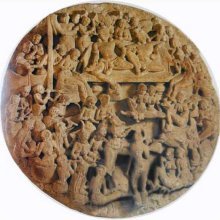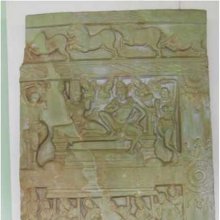Mandhata, Mandhātā, Māndhātā, Māndhāta: 11 definitions
Introduction:
Mandhata means something in Buddhism, Pali, Hinduism, Sanskrit, Marathi. If you want to know the exact meaning, history, etymology or English translation of this term then check out the descriptions on this page. Add your comment or reference to a book if you want to contribute to this summary article.
Images (photo gallery)
In Hinduism
Natyashastra (theatrics and dramaturgy)
Source: archive.org: The mirror of gesture (abhinaya-darpana)One of the Hands of Famous Emperors.—For the Lords of the Earth Mandhātā and Marutvān, Mukula, Sūci and Muṣṭi hands and the Ardha-patāka twisted upwards touching the body, these four hands are used in order.

Natyashastra (नाट्यशास्त्र, nāṭyaśāstra) refers to both the ancient Indian tradition (shastra) of performing arts, (natya—theatrics, drama, dance, music), as well as the name of a Sanskrit work dealing with these subjects. It also teaches the rules for composing Dramatic plays (nataka), construction and performance of Theater, and Poetic works (kavya).
Purana and Itihasa (epic history)
Source: Wisdom Library: Bhagavata PuranaMāndhātā (मान्धाता):—Son of Yuvanāśva (son of Senajit). He was born from the lower right side of King Yuvanāśva's abdomen, after the king drank sanctified water meant for his wife (during a sacrifice). Because Rāvaṇa and other bandits feared him, he was also called Trasaddasyu. He had three sons by his wife Bindumatī (daughter of Śaśabindu), named Purukutsa, Ambarīṣa, and Mucukunda. These three brothers had fifty sisters, who all accepted the great sage Saubhari as their husband. (see Bhāgavata Purāṇa 9.6.33-34,38)
Source: archive.org: Puranic EncyclopediaMāndhātā (मान्धाता).—A King of pre-eminence in the dynasty of Ikṣvāku. Genealogy. Descending in order from Viṣṇu were born—Brahmā—Marīci—Kaśyapa—Vivasvān—Ikṣvāku—Vikukṣi—Śaśāda—Purañjaya—Kakutstha—Anenas—Pṛthulāśva—Prasenajit—Yuvanāśva—Māndhātā. (See full article at Story of Māndhātā from the Puranic encyclopaedia by Vettam Mani)
Source: Cologne Digital Sanskrit Dictionaries: The Purana IndexMāndhāta (मान्धात).—(Māndhātri)—a son of Yuvanāśva, was born of him by splitting open the right side of his stomach; to the crying child Indra gave his first finger to suckle and called him Trasadasyu (s.v.) as he was a terror to the Dasyus; celebrated as a great emperor by the Paurāṇikas, having lust for more territory; married (Bindumatī) Caitrarathī, daughter of Śaśabindu, (Satabindu, Viṣṇu-purāṇa); had three sons, Purukusta, Ambarīṣa, and Mucukunda besides fifty daughters, all of whom were married to Saubhari;1 he built for them crystal palaces; gave them all comforts and himself lived constantly with each of them by his yogic powers; they gave birth to 150 sons and Māndhāta visited them after a long time and found them happy; was blessed by the sage and returned home; a Kṣatropetadvija;2 an incarnation of Viṣṇu as human being with Uthathya, in the 15th Treta (with Uttankapurohita in the 15th Tretāyuga, Matsya-purāṇa);3 an Angirasa and mantrakṛt;4 worshipped Hari as yajña, knew the yoga power of Hari and got over his māyā;5 a great conquering monarch; a popular king, a yajva, of good character;6 became a Brahmana;7 Tattya was his purohita.8
- 1) Bhāgavata-purāṇa IX. 6. 30-38; 7. 1; X. 51. 14; XII. 3. 9; Vāyu-purāṇa 99. 130; Viṣṇu-purāṇa IV. 2. 61-112; Brahmāṇḍa-purāṇa III. 63. 68-72; Matsya-purāṇa 12. 34; 49. 8.
- 2) Brahmāṇḍa-purāṇa III. 66. 86.
- 3) Ib. III. 73. 90; Matsya-purāṇa 47. 243; Vāyu-purāṇa 98. 90.
- 4) Brahmāṇḍa-purāṇa II. 32. 108; Matsya-purāṇa 145. 102; Vāyu-purāṇa 59. 99.
- 5) Bhāgavata-purāṇa II. 7. 44.
- 6) Vāyu-purāṇa 88. 66-70.
- 7) Ib. 91. 115.
- 8) Ib. 99. 130.

The Purana (पुराण, purāṇas) refers to Sanskrit literature preserving ancient India’s vast cultural history, including historical legends, religious ceremonies, various arts and sciences. The eighteen mahapuranas total over 400,000 shlokas (metrical couplets) and date to at least several centuries BCE.
Vaishnavism (Vaishava dharma)
Source: VedaBase: Śrīmad Bhāgavatam 9.6.39-40According to Viśvanātha Cakravartī Ṭhākura, Māndhātā was the king of Mathurā, and Saubhari Ṛṣi was engaged in austerity while submerged deep within the River Yamunā.

Vaishnava (वैष्णव, vaiṣṇava) or vaishnavism (vaiṣṇavism) represents a tradition of Hinduism worshipping Vishnu as the supreme Lord. Similar to the Shaktism and Shaivism traditions, Vaishnavism also developed as an individual movement, famous for its exposition of the dashavatara (‘ten avatars of Vishnu’).
General definition (in Hinduism)
Source: Apam Napat: Indian MythologyMandhata is a king of the Solar dynasty, the son of Yuvanashva, and an ancestor of Rama. (Note: There is an alternate interpreation that makes Mandhata the other name of Yuvanashva). His son is Susandhi.
In Buddhism
Theravada (major branch of Buddhism)
Source: Pali Kanon: Pali Proper NamesA primeval king, descended from Mahasammata, Roja, Vararoja, Kalyana, Varakalyana and Uposatha, the last named being his father. He was thus an ancestor of the Sakiyans. J.ii.311; iii.454; Mtu.ii.2; Dpv.iii.5; but see SNA.i.352, where the genealogy is slightly different.
He had the seven Jewels of a Cakka vatti and his four Supernatural Powers. When he clenched his left hand and touched it with his right, a shower of the seven kinds of jewels fell knee deep from the sky. For eighty four thousand years he was a prince, for eighty four thousand a viceroy, and for eighty four thousand more a king. His life span was an asankheyya. But he grew discontented, and, at the suggestion of his ministers, visited the deva world. First he went to the Catummaharajika world, where he ruled; but still unsatisfied, he went to Tavatimsa. There Sakka welcomed him and gave him half his kingdom. Mandhata ruled there during the lifetime of thirty six Sakkas, each Sakkas life lasting for thirty six million years and sixty times one hundred thousand. As time went on, Mandhatas craving increased; he wished to kill Sakka and gain the whole kingdom. Because of his greed his power waned, and he fell from heaven into his park. The gardener announced his arrival to the royal family, and they provided a resting place for him and there he lay dying. When asked for a message for his people, he wished them to know how even he, in spite of his great pomp and power, had to die (J.ii.311ff.; DA.ii.481f.; MA.i.182f.; cp. Dvy.210ff).
Mandhata is identified with the Bodhisatta (J.ii.314). His son was Varamandhata, whose son was Cara and grandson Upacara (or Apacara) (J.iii.454; Dpv.iii.6). Mandhata ruled at Rajagaha (SNA.ii.413; DA.i.132), and is named as one of the four persons who attained, while yet in their earthly bodies, to the glory of the gods. Mil. 115, 291; MA.ii.737f.; the others being Guttila, Sadhina and Nimi.
He is considered as chief of those given up to the pleasures of the senses and as an example of one whose desires could never be satisfied. A.ii.17; AA.ii.474; e.g., VibhA.506. Thig.486.
When Mandhata went to the deva world he was accompanied by inhabitants of all the four continents. After his return to earth, however, the Cakkaratana, stuck fast in the ground, and the others could not return to their homes. They thereupon begged for the intervention of the minister (Parinayaka), who was carrying on the government with Mandhatas shoes on the throne. He gave them lands in Jambudipa. There those who came from Pubba Videha called their land Videharattha; those from Apara goyana called it Aparantajanapada, and those from Uttarakuru dwelt in what afterwards came to be known as Kururattha. DA.ii.482; MA.i.183f.
Theravāda is a major branch of Buddhism having the the Pali canon (tipitaka) as their canonical literature, which includes the vinaya-pitaka (monastic rules), the sutta-pitaka (Buddhist sermons) and the abhidhamma-pitaka (philosophy and psychology).
Mahayana (major branch of Buddhism)
Source: Brill: Śaivism and the Tantric Traditions (mahayana)Māndhātā (मान्धाता) is the name of an ancient Bodhisattva and Cakravartin king, according to the Nārāyaṇaparipṛcchā.—The setting of this scripture is Mount Svarṇaśṛṅga, the mansion of Vaiśravaṇa, where Nārāyaṇa requests help from the Buddha upon defeat by the Asuras, much like the Dhvajāgrakeyūradhāraṇī. The lord tells him that earlier, during the reign of King Ratnaśrī of Magadha, there lived Sarveśvara Tathāgata, from whom the Bhagavān learned the Mahāmāyāvijayavāhinī spell. For hundreds of thousands of years that king ruled righteously by the power of this dhāraṇī. In his next existence he was born as Māndhātā, a Bodhisattva and Cakravartin king, who practiced charity for sixty-four thousand kalpas and became a Buddha. [...]

Mahayana (महायान, mahāyāna) is a major branch of Buddhism focusing on the path of a Bodhisattva (spiritual aspirants/ enlightened beings). Extant literature is vast and primarely composed in the Sanskrit language. There are many sūtras of which some of the earliest are the various Prajñāpāramitā sūtras.
General definition (in Buddhism)
Source: Wisdom Library: BuddhismMāndhāta (मान्धात) is the name of an ancient king from the Solar dynasty (sūryavaṃśa) and a descendant of Mahāsaṃmata, according to the Mahāvastu of the Mahāsaṃghikas (and the Lokottaravāda school). Māndhāta can also be spelled as Māndhātā, according to the Dulva (the Tibetan translation of the Vinaya of the Sarvāstivādins).
Māndhāta is known as Mandhātar according to the Dīpavaṃśa and the Mahāvaṃśa.
Māndhāta is known as Māndhātṛ or Mūrdhāta according to the Mahāprajñāpāramitāśāstra, an encyclopedic work on Buddhism written by Nāgārjuna.
Māndhāta is known as Mandhātu according to the Mahābuddhavaṃsa or Maha Buddhavamsa (the great chronicle of Buddhas) Anudīpanī chapter 1, compiled by Ven. Mingun Sayadaw.
Languages of India and abroad
Marathi-English dictionary
Source: DDSA: The Molesworth Marathi and English Dictionarymandhaṭa (मंधट).—a (Better mandaṭa) Slow, sluggish, dull of movement.
Marathi is an Indo-European language having over 70 million native speakers people in (predominantly) Maharashtra India. Marathi, like many other Indo-Aryan languages, evolved from early forms of Prakrit, which itself is a subset of Sanskrit, one of the most ancient languages of the world.
Sanskrit dictionary
Source: Cologne Digital Sanskrit Dictionaries: Edgerton Buddhist Hybrid Sanskrit DictionaryMāndhāta (मान्धात) or Māndhātṛ.—(and other forms, see below; = Pali Mandhātā, n. sg., stem °tu-; there seems to be nothing in Buddhist legend suggesting identity with Sanskrit Mān- dhātṛ, except the name), name of an ancient cakravartin king, sometimes (e.g. in Laṅkāvatāra-sūtra, also in Pali) regarded as a pre- vious incarnation of Śākyamuni: °taḥ, °to, n. sg., Mahāvyutpatti 3558; Mahāvastu i.348.9; Divyāvadāna 210.20; 214.20; °tasya Mahāvastu i.348.9; Divyāvadāna 210.21; 213.23; Mūla-Sarvāstivāda-Vinaya i.67.14 ff.; 93.6 ff.; (Ārya-)Mañjuśrīmūlakalpa 609.1; °tṛ- (stem in composition) Karmavibhaṅga (and Karmavibhaṅgopadeśa) 37.3; °tā, n. sg., Mahāvastu i.154.1; Divyāvadāna 210.23; 214.21; Karmavibhaṅga (and Karmavibhaṅgopadeśa) 36.11; Laṅkāvatāra-sūtra 141.5; (Ārya-)Mañjuśrīmūlakalpa 608.22; °tuḥ, gen. sg., Divyāvadāna 278.13; 576.10, etc.; Mādhātaḥ, cited as used by ‘some’, Divyāvadāna 210.21; Mūrdhātaḥ (q.v.), as n. sg. Mahāvyutpatti 3557 (so v.l. of Mironov, who reads Mūr- dhagataḥ, Kyoto ed. Mūrdhataḥ), also Divyāvadāna 210.19, and forms of this stem are much used in this Divyāvadāna and Mūla-Sarvāstivāda-Vinaya story, interchangeably with stems Māndhāta and °tṛ; e.g. Mūrdhātasya Divyāvadāna 212.9, 18; °tena 212.19, 22.
--- OR ---
Māndhāta (मान्धात) or Mūrdhāta.—q.v.: Divyāvadāna 210.19 ff., where (as in Mūla-Sarvāstivāda-Vinaya below) the identity is explicitly stated; read °ātaḥ for Mūrdhataḥ, n. sg., in Mahāvyutpatti 3557, where Mironov Mūrdhagataḥ, but most of his mss. Mūrdhātaḥ; with [etymology] explanation (mūrdhni jātaḥ) Mūla-Sarvāstivāda-Vinaya i.67.10—11; 93.7—8.
Sanskrit, also spelled संस्कृतम् (saṃskṛtam), is an ancient language of India commonly seen as the grandmother of the Indo-European language family (even English!). Closely allied with Prakrit and Pali, Sanskrit is more exhaustive in both grammar and terms and has the most extensive collection of literature in the world, greatly surpassing its sister-languages Greek and Latin.
See also (Relevant definitions)
Starts with: Mandhataki, Mandhatapura, Mandhatar.
Ends with: Dharmandhata, Maha Mandhata, Varamandhata.
Full-text (+92): Yauvanashva, Yuvanashva, Mandhatri, Purukutsa, Bindumati, Murdhata, Trasaddasyu, Mucukunda, Omkareshvara, Narmada, Saubhari, Ambarisha, Maha Mandhata, Madhata, Dharmasena, Tathya, Mahishmati, Yuvanashvaja, Vaishnava, Varakalyana.
Relevant text
Search found 41 books and stories containing Mandhata, Mandhātā, Māndhātā, Māndhāta, Mandhaṭa; (plurals include: Mandhatas, Mandhātās, Māndhātās, Māndhātas, Mandhaṭas). You can also click to the full overview containing English textual excerpts. Below are direct links for the most relevant articles:
Garga Samhita (English) (by Danavir Goswami)
Verse 2.14.25 < [Chapter 14 - Description of Kāliya’s Story]
Verse 4.19.2 < [Chapter 19 - A Thousand Names of Srī Yamunā]
Verse 4.20.1 < [Chapter 20 - The Killing of Pralamba]
Rig Veda (translation and commentary) (by H. H. Wilson)
The Matsya Purana (critical study) (by Kushal Kalita)
Part 1.3 - Incarnations of Viṣṇu < [Chapter 4 - Religious aspects of the Matsyapurāṇa]
Historical Elements in the Matsya Purana (by Chaitali Kadia)
Dynasty of Ikṣvāku < [Chapter 6 - Human history in the Matsya-Purāṇa]
Human History in the Purāṇa < [Chapter 3 - Historical elements in the Mahā-Purāṇas]
The State and organizations of Kingdoms < [Chapter 5 - Cultural history in the Matsya-Purāṇa]
Ramayana of Valmiki (by Hari Prasad Shastri)
Chapter 67 - The Story of Mandhata < [Book 7 - Uttara-kanda]
Chapter 23d - Ravana’s Encounter with the King Mandhata < [Book 7 - Uttara-kanda]
Chapter 110 - Vasishtha calls upon Rama to return < [Book 2 - Ayodhya-kanda]



